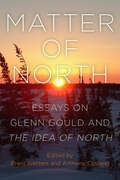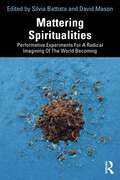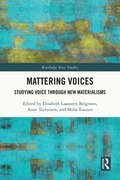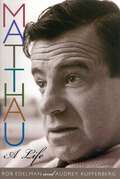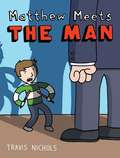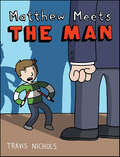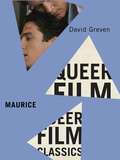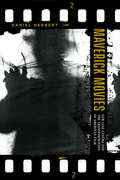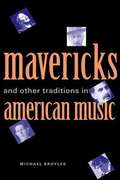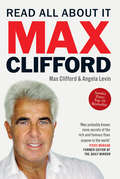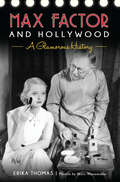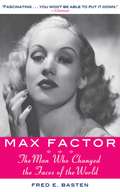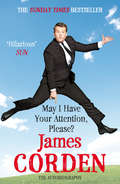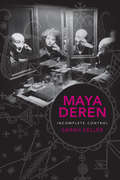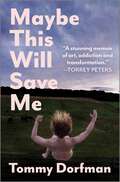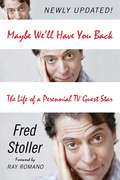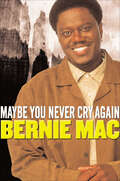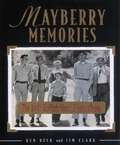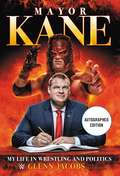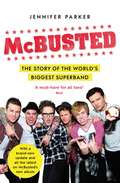- Table View
- List View
Matter of North: Essays on Glenn Gould and The Idea of North
by Brent Wetters Anthony CushingDocuments and illuminates Glenn Gould's groundbreaking radio composition, The Idea of North.Matter of North collects essays and source material related to Glenn Gould's landmark 1967 radio documentary The Idea of North. The most famous product (other than his studio piano recordings) of Gould's 1964 decision to abandon the concert stage for the recording studio, it combines Gould's interests in the contrapuntal (by the simultaneous layering of speaking voices) with philosophy and a life-long fascination with the Canadian Arctic. Because the documentary is a multivalent work, the contributors approach the documentary from unique perspectives (sociological, philosophical, music-theoretical, ethnomusicological), each illuminating a salient aspect of the work. The source-material section includes for the first time the complete interview responses by Gould's five participants, along with other important documentation.
Mattering Spiritualities: Performative Experiments for a Radical Imagining of the World Becoming (Routledge Advances in Theatre & Performance Studies)
by David Mason Silvia BattistaMattering Spiritualities brings together an array of international scholars and practitioners to explore spirituality in embodiment through the lens of performance, performative writing, and performance studies.The book concerns spirituality and takes the body as the site of whatever it is we call spirituality. The methodological assumption is that the opposition of body and spirit is a false binary that calls for re-examination and revision. It stems from the argument that people can deliberately shift their boundaries of perception and knowing through practice, technologies and performative techniques that can alter the way in which they perceive the ecologies in which they are embedded. This approach understands that careful attention to which bodies are performing in any given scenario is crucial, as is a sensitivity to the ramifications of any body’s race, gender, class, and biological ability. Performance can therefore be regarded as anything through which individuals and collectives experiment with bodies as technologies. Each chapter engages with such experiments to explore how bodies experience and relate to other bodies, human and other-than-human, but also how, by mobilizing bodies and changing relationships between them, practitioners can transform people, spaces and places, objects, ecologies large and small, and shift the borders-of-the-known. Such experiments can also reveal intersectional dynamics within given social, political, and biological borders offering new perspectives and angles of analysis.This collection intends to serve transdisciplinary studies and to support varied learning and teaching environments for undergraduate, postgraduate, and PhD students.
Mattering Voices: Studying Voice through New Materialisms (Routledge Voice Studies)
by Milla Tiainen Anne TarvainenMattering Voices advances mutually enriching relationships in-between the transdisciplinary fields of voice studies and new materialisms.This is the first edited volume to explore how the theoretical, methodological, and analytical possibilities of both voice scholarship and new materialisms gain further depth and directions through their co-constitutive—intra-active—relationality. In this book, voice researchers from performance studies and philosophy, artistic research, musicology, ethnomusicology, sound studies, feminist and gender research, and educational studies develop new materialisms-influenced approaches to voice and voice studies-inspired adaptations of new materialisms in the empirical study of various kinds of voicing. The topics covered range from voice in artistic practices and contemporary academia to new notions of musicality and vocal atmospheres, as well as the significance of singing in gendered senses of self and interspecies relations. By experimenting with intra-actions of voice studies and new materialisms, the book proposes fresh ways of researching and grasping how voices matter: how they materialize as events and practices and acquire meanings.As a polyphony of voices, this volume invites readers into entangled conversations about how voice emerges— creating modes of being, knowing, and co-existing—and what it might still become.
Matthau: A Life
by Rob Edelman Audrey KupferbergFunny yet down-to-earth, honest yet full of exaggeration, actor Walter Matthau (1920-2000) will always occupy a place in America's heart as one of the great comic talents of his generation. Born Walter Matuschanskayasky into Jewish tenements on New York's Lower East Side, he was a child actor in New York Yiddish theater, and later a World War II Air Force radioman-gunner. He paid dues for ten years on Broadway, in summer stock, and on television before landing his film debut The Kentuckian in 1955. By the time of his 1968 casting as cantankerous but lovable slob Oscar Madison in the film version of Neil Simon's The Odd Couple, Matthau had won major Hollywood stardom.Based on dozens of interviews and extensive research, this book covers the breadth of his often-complicated personal life and multi-faceted career, including his unforgettable performances in such films as The Fortune Cookie, A Guide for the Married Man, Plaza Suite, Charley Varrick, The Taking of Pelham One Two Three, The Sunshine Boys, The Bad News Bears, California Suite, and Grumpy Old Men.
Matthew Meets the Man
by Travis NicholsMatthew Swanbeck has a classic problem. Back in seventh grade, his dad talked him into playing the trumpet instead of the drums. Now he's a lowly brass player in the school marching band. Until one day he has an epiphany: He can start his own band, play in all the cool rock venues, even go on tour . . . if only he can scrape together the cash to buy a drum set. But how will he ever get the money together when The Man thwarts him at every turn, taking taxes out of his paycheck, forcing him to mow the lawn for a measly $10 a week, and creating all of those rules that get in the way of dreams? It's one teen against the system in this light-hearted look at the challenges and rewards of chasing your dreams.
Matthew Meets the Man
by Travis NicholsMatthew Swanbeck has a classic problem. Back in seventh grade, his dad talked him into playing the trumpet instead of the drums. Now he's a lowly brass player in the school marching band. Until one day he has an epiphany: He can start his own band, play in all the cool rock venues, even go on tour ... if only he can scrape together the cash to buy a drum set. But how will he ever get the money together when The Man thwarts him at every turn, taking taxes out of his paycheck, forcing him to mow the lawn for a measly $10 a week, and creating all of those rules that get in the way of dreams? It's one teen against the system in this light-hearted look at the challenges and rewards of chasing your dreams.
Maud Powell, Pioneer American Violinist
by Karen A. Shaffer Neva G. GreenwoodBiography of the first American violinist to gain international rank.
Maurice (Queer Film Classics #8)
by David GrevenMaurice, James Ivory’s 1987 adaptation of the E.M. Forster novel, follows an Edwardian man’s journey from the awakening of his desire for and love of men to self-acceptance. One of the most politically resistant films of the 1980s, Maurice dared to depict a young man’s coming-out story and a happy ending for its lovers, Maurice and Alec.James Ivory and producer Ismail Merchant, a couple whose cinema is synonymous with period film adaptation, released Maurice during the first AIDS decade, a time of flagrant transatlantic homophobia. Criticism following its release described Ivory as a superficial and staid director, while the film was received as a regression to the uncinematic and overly faithful style that characterized the early adaptations by Merchant Ivory Productions. Offering a close reading of Forster’s novel and an analysis of Ivory’s distinctive visual style, Richard Robbins’s indelible score, and the performances of James Wilby, Hugh Grant, and Rupert Graves, David Greven argues that the film is a model of sympathetic adaptation. This study champions the film as the finest of the Merchant Ivory works, making a case for Ivory’s underappreciated talents as a director of great subtlety and intelligence, and for the film as one worth recuperating from its detractors.Understanding Maurice as a fully realized work of art and adaptation, this volume offers insight into how a stunning novel of gay love became a classic of queer film.
Maverick Movies: New Line Cinema and the Transformation of American Film
by Daniel HerbertA free ebook version of this title is available through Luminos, University of California Press’s Open Access publishing program. Visit www.luminosoa.org to learn more.Maverick Movies tells the improbable story of New Line Cinema, a company that cut a remarkable path through the American film industry and movie culture. Founded in 1967 as an art film distributor, New Line made a small fortune running John Waters's Pink Flamingos at midnight screenings in the 1970s and found reliable returns with the Nightmare on Elm Street franchise in the 1980s. By 2001, the company competed with the major Hollywood studios and reached global box office success with the Lord of the Rings franchise. Blurring boundaries between high and low culture, between independent film and Hollywood, and between the margins and the mainstream, New Line Cinema epitomizes Hollywood's shift in focus from the mass audience fostered by the classic studios to the multitude of niche audiences sought today.
Mavericks and Other Traditions in American Music
by Michael BroylesFrom colonial times to the present, American composers have lived on the fringes of society and defined themselves in large part as outsiders. In this stimulating book Michael Broyles considers the tradition of maverick composers and explores what these mavericks reveal about American attitudes toward the arts and about American society itself. Broyles starts by examining the careers of three notably unconventional composers: William Billings in the eighteenth century, Anthony Philip Heinrich in the nineteenth, and Charles Ives in the twentieth. All three had unusual lives, wrote music that many considered incomprehensible, and are now recognized as key figures in the development of American music. Broyles goes on to investigate the proliferation of eccentric individualism in all types of American music--classical, popular, and jazz--and how it has come to dominate the image of diverse creative artists from John Cage to Frank Zappa. The history of the maverick tradition, Broyles shows, has much to tell us about the role of music in American culture and the tension between individualism and community in the American consciousness.
Max Clifford: Read All About It
by Angela Levin Max Clifford'Max knows more secrets of the rich and famous than anyone in the world'Piers MorganMax Clifford is the media guru everyone calls when they want to know about a celebrity story or a celebrity's relationship with the media. Starting out as a junior member of the press department at EMI, he has become one of the most influential figures in today's society, and a household name. What is less known is the other side to Max: the stories he keeps out of the papers; his stand against corruption; his mischievous sense of humour; his dedication to helping people from all walks of life;his love for his wife of nearly forty years who tragically died of cancer; and his devotion to his daughter Louise who, at six,was diagnosed with juvenile rheumatoid arthritis and is permanently disabled. The essential memoir for those interested in both PR and celebrity.
Max Factor and Hollywood: A Glamorous History
by Erika ThomasThe story of the makeup artist who changed the film industry—and the world of modern cosmetics. Includes photos. When Polish wigmaker and cosmetician Max Factor arrived in Los Angeles at the dawn of the motion picture industry, &“make-up&” had been associated only with stage performers and ladies of the oldest profession. Appalled by the garish paints worn by actors, Factor introduced the first &“flexible&” greasepaint for film in 1914. With a few careful brush strokes, a lot of innovation, and the kind of luck that can happen only in Hollywood, Max Factor changed the meaning of glamour. His innovations can be experienced in every tube of lipstick, palette of eye shadow, and bottle of nail lacquer used today. Join author Erika Thomas as she reveals the makeup guru's expert beauty tips and the story of how he created the most iconic golden-era looks that are as relevant today as they were nearly a century ago.
Max Factor: The Man Who Changed the Faces of the World
by Fred E. BastenNice women never wore makeup. Even the word was taboo in polite society--until Max Factor entered the scene. Born in Poland in 1877, Factor worked as a beautician for the Russian royal family, the Romanovs. In 1904, he fled to America, where he opened a cosmetics store in Los Angeles. Creating makeup originally for silent films, then the talkies, and, ultimately, color motion pictures, Factor designed looks for Katharine Hepburn, Rita Hayworth, Bette Davis, and countless other beauties of the day. Soon women everywhere wanted to look like their favorite glamorous stars, and Factor was there to help, bringing his innovative cosmetics to the general public. He revolutionized the world of beauty by producing many firsts: false eyelashes, lip gloss, foundation, eye shadow, the eyebrow pencil, concealer, wand-applicator mascara, and water-resistant makeup. A true innovator, he also introduced the concept of color harmony and the celebrity-endorsed cosmetics advertising that forms the glamorous backbone of the modern industry. Max Factor was the father of modern makeup. This is his extraordinary story.
Max Found Two Sticks
by Brian PinkneyIt was a day when Max didn't feel like talking to anyone. He just sat on his front steps and watched the clouds gather in the sky. A strong breeze shook the tree in front of his house, and Max saw two heavy twigs fall to the ground.
Maxi, the Star
by Sal Barracca Debra BarraccaMaxi and Jim take their taxi cross-country so that Maxi can do a screen test for Doggie Bites.
May I Have Your Attention Please?
by James CordenTHE SUNDAY TIMES BESTSELLING AUTOBIOGRAPHYSo... the story of my life. I've often thought about this moment, about what it would be like to write my memoirs. I always thought it would make me feel important. It doesn't. If anything it makes me feel a little strange.The truth is, I should never have been this famous guy. I wasn't the cool, clever, good-looking boy at school. But I always dreamt of it, hoped for it, longed for it: throughout school when I was disruptive, in my teens when I tried to form my own boy band and through hundreds of auditions for parts which were met with constant rejection. Until finally I co-wrote Gavin and Stacey. And my whole life changed...This is that story. The story of how I found myself here, talking to you.
Maya Deren
by Sarah KellerAssesses both the filmmaker's completed work and her numerous unfinished projects, arguing Deren's overarching aesthetic is founded on principles of incompletion, contingency, and openness
Maybe This Will Save Me: A Memoir of Art, Addiction and Transformation
by Tommy Dorfman*An Autostraddle Most Anticipated Queer Book*&“I&’m determined to get to know the real Tommy, to trace the shape of my scars.&”For years, Tommy Dorfman turned her back on her thoughts and emotions, hoping they&’d simply go away. After a lifetime of confusion, she finally gained clarity around her gender and began to transition. But there were still parts of herself she&’d locked away, elements of her story that she needed, for the first time, to fully confront. She sought guidance in a tarot deck.Maybe This Will Save Me is structured through the cards of that tarot pull. The youngest of five children, she grappled with her own identity from an early age and spent her teenage years numbed by drugs and alcohol. At the same time, she harbored dreams of creative stardom and a desire to make herself seen. Charting her early struggles in theater, her rise to fame in 13 Reasons Why, her hard-fought journey to sobriety, and the relationships that shaped her, Maybe This Will Save Me is a luminously written, bracingly honest, and structurally audacious memoir of an artist whose vision transcends mediums.
Maybe We'll Have You Back: The Life of a Perennial TV Guest Star
by Fred Stoller"I don’t know why Fred was never a regular on a show. Maybe because he’s annoying . . . just kidding!” --Ray Romano Fred Stoller has played the annoying schnook in just about every sitcom you’ve seen on TV--Friends, Everybody Loves Raymond, Scrubs, Hannah Montana, My Name Is Earl--and was even a staff writer for Seinfeld, but he’s never found a solid gig. When it comes to Hollywood, it’s a case of always the bridesmaid and never the bride, except in his case he’s always the snarky waiter, the mopey cousin, or Man #2. This hilarious and bittersweet rags to rags story of the hardest-working guy in showbiz follows Fred, who started his career as a stand-up comic, from set to set as he tries to find a permanent home for his oddball character. With candor, Fred shares stories of his great adventures pounding the Hollywood pavement, including a humiliating encounter with Billy Crystal, a disastrous one-night stand with Kathy Griffin, and plenty of awkward run-ins at craft service tables. And he always shares his ups and downs with his skeptical, yet loving, mother waiting by the phone in Brooklyn. Everyone can relate to searching for a dream job or waiting for the next big break, and will root for Fred as he weaves his way through the cutthroat world of Tinseltown.
Maybe You Never Cry Again
by Bernie Mac“Entertainingly tells the life story of one of today's top comedians . . . an uplifting-and humorous-rags to riches story, told with heart.” —Publishers WeeklyBy the tender age of five, Bernie Mac had found his calling: making others laugh. He has since become the star and cocreator of Fox’s hit sitcom The Bernie Mac Show; a stand-up legend; and a hit movie star in Head of State and Charlie’s Angels: Full Throttle. Now this amazing comedian delves deep down inside to retell the poignant and hilarious story of his childhood and the people who helped shape him into the comedian—and the strong and self-reliant man—he is today.When young Bernie Mac lost his beloved mother to breast cancer, and faced an astounding number of other hardships, he remembered the “Mac-isms” she taught him: You have to meet all of the challenges, big and small. Because how you start is how you finish. If you want a helping hand, look at the end of your arm. These tough-love lessons gave him an inner strength that led him to choose hope over despair, and to follow his dreams. Maybe You Never Cry Again is a powerful testament to how a mother’s love made everything possible for Bernie Mac by teaching him to believe in himself.
Maybe Your Leg Will Grow Back!: Looking on the Bright Side with Baby Animals
by Ben Schwartz Amanda McCallFinding the bright side of a terrible situation has never been easier, thanks to the adorable baby animal postcards found in Maybe Your Leg Will Grow Back. Amanda McCall and Ben Schwartz, nationally bestselling authors of Grandma’s Dead and Why is Daddy in a Dress?, are back with their third collection of cuteness designed to soften life’s unexpected blows, whether you’re dealing with shark attacks, incurable diseases, or incarcerations in filthy third world prisons. With delicious dark humor in vein of The Bunny Suicides, Maybe Your Leg Will Grow Back even includes a bonus DIY crafts section to help you find the sunny side of any catastrophe.
Mayberry Memories: The Andy Griffith Show Photo Album
by Jim ClarkMayberry Memories: The Andy Griffith Show Photo Album is the most beautiful coffee-table book ever to be released on one of the most beloved television shows in history. Celebrating the 40th anniversary of THE ANDY GRIFFITH SHOW, this book features nearly 300 beautifully reproduced photographs in both color and black and white, the majority of which have never before been published. MAYBERRY MEMORIES is the ultimate keepsake memento for fans who have enjoyed everything Mayberry for four decades.
Mayor Kane: My Life in Wrestling and Politics
by Glenn JacobsThe surprising story of how wrestling superstar Glenn "Kane" Jacobs beat all the odds to become the mayor of Knox County, Tennessee.Even in his heyday in wrestling, Jacobs was inspired to pursue politics by popular libertarian figures such as former Republican presidential candidate Ron Paul, Republican Senator Rand Paul, Fox News' Judge Andrew Napolitano and others, and that led him to fulfill his own political ambitions.Before becoming Mayor Kane, Glenn "Kane" Jacobs was one of WWE's top Superstars for over two decades and traveled the globe with the likes of "Stone Cold" Steve Austin, Dwayne "The Rock" Johnson, John Cena, Ric Flair, and many others. He dominated the WWE with The Undertaker as the "Brothers of Destruction." Kane reinvented himself with the help of Daniel Bryan forming "Team Hell No." He set "Good ol' JR," Jim Ross on fire.The wrestler-turned-politician hasn't hung up his wrestling boots yet. Politics is a contact sport and Jacobs is using his wrestling skills in that arena. Jacobs supports President Trump and his agenda, and is implementing conservative policies in Tennessee.
Mazel Tov: Celebrities' Bar and Bat Mitzvah Memories
by Jill RappaportCelebrity journalist Jill Rappaport and photographer Linda Solomon offer an intimate glimpse of the bar or bat mitzvahs of some of the most talented people in entertainment, politics and business. This remarkable book brings together stories and never-before-seen family photos of a variety of public figures, as they look back on their thirteen-year-old selves and reminisce about the celebration that marked their transition into adulthood. The wonderfully candid interviews document deeply poignant, and often hilariously awkward, moments in these very public lives. Interviewees include Jeremy Piven, Senator Joseph Lieberman, Marlee Matlin, Richard Dreyfuss, Ronald Perelman, Howie Mandel, Gene Shalit, Harvey Fierstein, Judy Gold, Larry King, Donny Deutsch, Michael Kors, Charles Grodin, Josh and Andy Bernstein, and many others. Their experiences run the gamut: Kirk Douglas decided to be bar mitzvahed twice, while others, like Noah Wyle, always wanted one but never had the chance. There are stories of bar mitzvahs, bat mitzvahs, confirmations, and the only documented "bark" mitzvah, held in honor of two beloved pets. Though the stories vary greatly in their detail, they all express a common appreciation for values and traditions that have been passed down through the generations. Illustrated with photos pulled from family albums as well as contemporary portraits, Mazel Tov is an appealing tribute to the enduring bonds of faith and family.
McBusted
by Jennifer ParkerThis is the first book to tell the full inside story of the world's most awesome supergroup, McBUSTED. McBusted takes an exclusive look at the birth of Busted and McFly, two ground-breaking pop-rock bands who journeyed through sell-out arena tours with number-one hits, and the unique friendships that the boys shared from the very beginning. Packed with behind-the-scenes gossip, it follows the boys through the years, revealing the truth behind Busted's shock break-up and McFly's hiatus, the secrets of their private lives, and the roller-coaster ride that fame took them on - both the good times and the bad. In September 2013, McFly staged their tenth-anniversary show at the Royal Albert Hall and James and Matt were invited along as special guests to perform a medley of hits with the band. The reaction to the six-piece supergroup was stratospheric and the boys decided to take the new superband on tour - and lo, McBUSTED was born. McBusted walks side by side with Tom, James, Danny, Dougie, Matt and Harry as they build the band and provides a backstage pass into the tour, the fans and what the future might hold.
